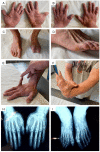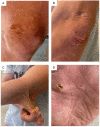Congenital Defects in a Patient Carrying a Novel Homozygous AEBP1 Variant: Further Expansion of the Phenotypic Spectrum of Ehlers-Danlos Syndrome Classical-like Type 2?
- PMID: 36553625
- PMCID: PMC9777638
- DOI: 10.3390/genes13122358
Congenital Defects in a Patient Carrying a Novel Homozygous AEBP1 Variant: Further Expansion of the Phenotypic Spectrum of Ehlers-Danlos Syndrome Classical-like Type 2?
Abstract
In 2018, a new clinical subtype, caused by biallelic variants in the AEBP1 gene, encoding the ACLP protein, was added to the current nosological classification of the Ehlers-Danlos Syndromes (EDS). This new phenotype, provisionally termed EDS classical-like type 2 (clEDS2), has not yet been fully characterized, as only nine cases have been reported to date. Here we describe a patient, homozygous for a novel AEBP1 pathogenic variant (NM_001129.5 c.2123_2124delTG (p.Val708AlafsTer5)), whose phenotype is reminiscent of classical EDS but also includes previously unreported multiple congenital malformations. Furthermore, we briefly summarize the current principal clinical manifestations of clEDS2 and the molecular evidence surrounding the role of AEBP1 in the context of extracellular matrix homeostasis and connective tissue development. Although a different coexisting etiology for the multiple congenital malformations of our patient cannot be formally excluded, the emerging role of ACLP in TGF-β and WNT pathways may explain their occurrence and the phenotypical variability of clEDS2.
Keywords: ACLP; AEBP1; Ehlers–Danlos Syndrome; Poland anomaly; TGF-β pathway; amniotic band sequence; clEDS2; cleft palate; multiple congenital anomalies.
Conflict of interest statement
The authors declare no conflict of interest.
Figures




Similar articles
-
Clinical and Molecular Characterization of a Novel Homozygous Frameshift Variant in AEBP1-Related Classical-like Ehlers Danlos Syndrome Type 2 with Comparison to Previously Reported Rare Cases.Genes (Basel). 2024 Apr 6;15(4):461. doi: 10.3390/genes15040461. Genes (Basel). 2024. PMID: 38674395 Free PMC article.
-
Expanding the Clinical and Mutational Spectrum of Recessive AEBP1-Related Classical-Like Ehlers-Danlos Syndrome.Genes (Basel). 2019 Feb 12;10(2):135. doi: 10.3390/genes10020135. Genes (Basel). 2019. PMID: 30759870 Free PMC article.
-
Bi-allelic Alterations in AEBP1 Lead to Defective Collagen Assembly and Connective Tissue Structure Resulting in a Variant of Ehlers-Danlos Syndrome.Am J Hum Genet. 2018 Apr 5;102(4):696-705. doi: 10.1016/j.ajhg.2018.02.018. Epub 2018 Mar 29. Am J Hum Genet. 2018. PMID: 29606302 Free PMC article.
-
AEBP1 or ACLP, which is the key factor in inflammation and fibrosis?Int J Biol Macromol. 2025 May;310(Pt 4):143554. doi: 10.1016/j.ijbiomac.2025.143554. Epub 2025 Apr 26. Int J Biol Macromol. 2025. PMID: 40294683 Review.
-
DSE associated musculocontractural EDS, a milder phenotype or phenotypic variability.Eur J Med Genet. 2020 Apr;63(4):103798. doi: 10.1016/j.ejmg.2019.103798. Epub 2019 Oct 23. Eur J Med Genet. 2020. PMID: 31655143 Review.
Cited by
-
The Language of Pain in the Hypermobile Ehlers-Danlos Syndrome: Metaphors as a Key to Understanding the Experience of Pain and as a Rehabilitation Tool.Brain Sci. 2023 Jul 8;13(7):1042. doi: 10.3390/brainsci13071042. Brain Sci. 2023. PMID: 37508973 Free PMC article.
-
Inactive metallopeptidase homologs: the secret lives of pseudopeptidases.Front Mol Biosci. 2024 Jul 10;11:1436917. doi: 10.3389/fmolb.2024.1436917. eCollection 2024. Front Mol Biosci. 2024. PMID: 39050735 Free PMC article. Review.
-
Case report: further delineation of AEBP1-related Ehlers-Danlos Syndrome (classical-like EDS type 2) in an additional patient and comprehensive clinical and molecular review of the literature.Front Genet. 2023 May 5;14:1102101. doi: 10.3389/fgene.2023.1102101. eCollection 2023. Front Genet. 2023. PMID: 37214418 Free PMC article.
-
Clinical and Molecular Characterization of a Novel Homozygous Frameshift Variant in AEBP1-Related Classical-like Ehlers Danlos Syndrome Type 2 with Comparison to Previously Reported Rare Cases.Genes (Basel). 2024 Apr 6;15(4):461. doi: 10.3390/genes15040461. Genes (Basel). 2024. PMID: 38674395 Free PMC article.
References
-
- Alazami A.M., Al-Qattan S.M., Faqeih E., Alhashem A., Alshammari M., Alzahrani F., Al-Dosari M.S., Patel N., Alsagheir A., Binabbas B., et al. Expanding the clinical and genetic heterogeneity of hereditary disorders of connective tissue. Hum. Genet. 2016;135:525–540. doi: 10.1007/s00439-016-1660-z. - DOI - PubMed
-
- Blackburn P.R., Xu Z., Tumelty K.E., Zhao R.W., Monis W.J., Harris K.G., Gass J.M., Cousin M.A., Boczek N.J., Mitkov M.V., et al. Bi-allelic Alterations in AEBP1 Lead to Defective Collagen Assembly and Connective Tissue Structure Resulting in a Variant of Ehlers-Danlos Syndrome. Am. J. Hum. Genet. 2018;102:696–705. doi: 10.1016/j.ajhg.2018.02.018. - DOI - PMC - PubMed
Publication types
MeSH terms
Substances
LinkOut - more resources
Full Text Sources
Medical
Miscellaneous

